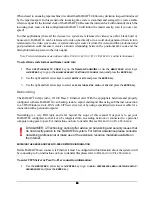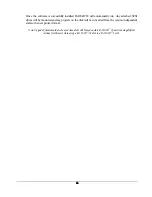
23
23
23
23
To slave RADAR
24 to external TDIF Word Sync:
1. Connect the TDIF word sync source to the
TDIF WORD SYNC IN
connector using a 75-ohm, BNC
terminated cable.
2. Press the
SYNC
key on the
Session Controller
or
KC-24
or use the
MENU/PREV
, arrow keys and
ENTER
key to go to the
MAIN / SYNC MENU / SYNC REFERENCE
menu and press the
ENTER
key.
3. Use the arrow keys to select
SYNC REFERENCE: TDIF WORD SYNC
and press the
ENTER
key.
Note: If you do not have TDIF cards installed then you will get an alert dialog stating:
NO TDIF CARDS INSTALLED
.
Digital I/O Format
The digital I/O formats available for selection will depend on the type and number of digital interface options
installed in your RADAR
24. All units ship with built in AES/EBU and S/PDIF 2-channel interfaces. The
24 channel digital I/O options available include: AES/EBU, ADAT and TDIF.
It is important to note that once a digital format is selected an appropriate clock source must be selected as
well. Many times they are one and the same thing, but not always. For instance, an AES transfer may be
required but the sync reference for all digital devices in the studio may be a word clock generator referenced
to video sync. You get the picture.
Using the
MAIN / DIGIO MENU/ DIGITAL I/O
ROUTING/ MULTI CH IN TRKS
menu dialog you can choose
ALL
or
SELECT
which tracks will use the selected digital I/O. The tracks that are not selected will use the analog I/O.
Note: When a digital input format is specified one track must always be set to digital. To return all 24 tracks to analog input
select NONE. See below.
NONE
This selection disengages the digital I/O and returns all 24 inputs to analog input.
AES/EBU 2-CHANNEL
This 2-channel format uses a single cable for 2 channels of digital audio transmission. It is unidirectional so
one cable is required for input and one for output.
S/PDIF 2-CHANNEL
S/PDIF also uses a single cable for 2 channels of digital audio transmission. It is unidirectional as well so one
cable is required for input and one for output. It is essentially a consumer version of AES/EBU.
AES MULTI-CHANNEL
With multi-channel AES/EBU each cable carries eight channels. This format is bi-directional so only three
cables are required for 24 channels of digital audio I/O.






























